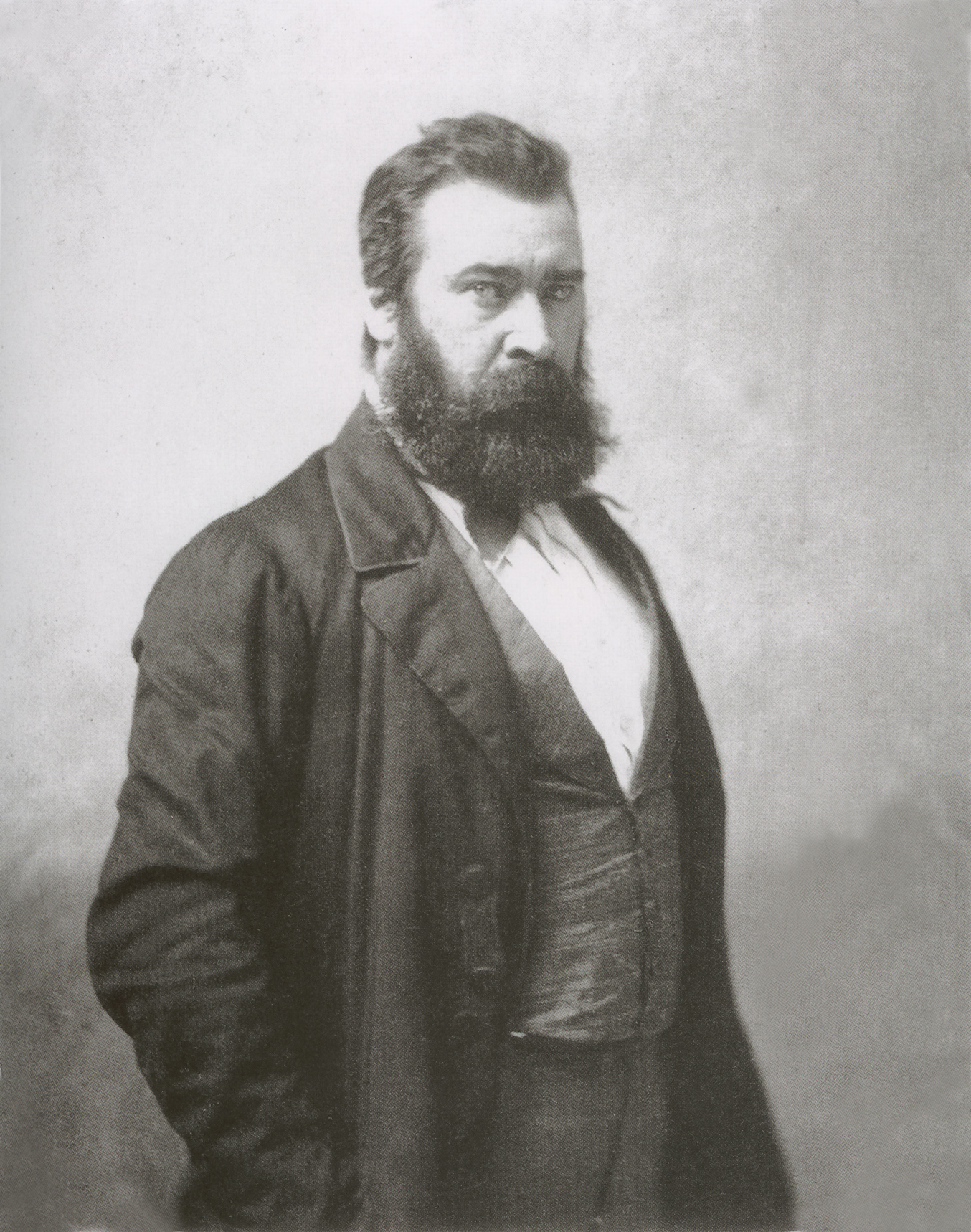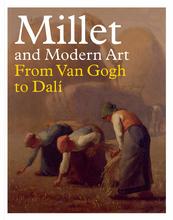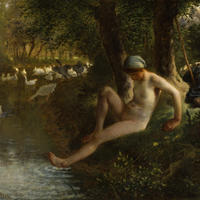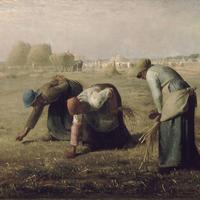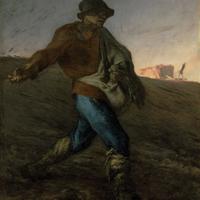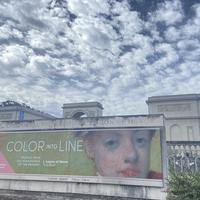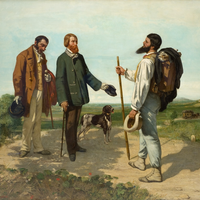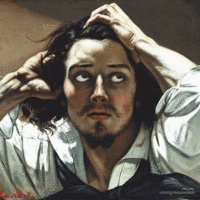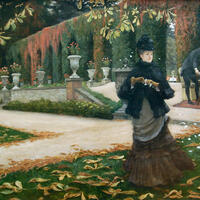More about Jean-François Millet
- All
- Info
- Shop
Works by Jean-François Millet

Contributor
If you invited Jean-François Millet to a house party back in 1870, he’d either paint the guests as weary victims of life’s monotony or skip the shindig entirely to tend to his vegetable patch.
Life was not easy for Millet, a nature fiend for whom lucky breaks always came too little, too late. Born to a farming family in France, Millet would hold onto two values from childhood: his Christian faith and the land he sowed. Despite his profound influence on French art (he inspired Monet and Seurat and was a frequent character in van Gogh’s letters) Millet lived from paycheck to paycheck, as short on funds as he was on love for Parisian smog. Millet once proclaimed that he was born a peasant and would die one, a creed he backed up with his compact barn house and longtime residence in rural Barbizon. There, he painted peasant farmers in varying degrees of distress and discomfiting toil, sharing in their lot himself to keep his family afloat.
Millet’s life was a string of tragedies. His first wife died of consumption in 1843, the same year he was turned down by the Paris Salon. His tour de force, The Captivity of the Jews in Babylon, was so reviled by its audience that Millet painted over it when supplies were scarce. Millet’s masterpiece The Angelus would fetch a pretty penny, but only when it was resold after his passing. He held Théodore Rousseau as he passed away, a close friend who once bought Millet’s painting under another name to aid him during a financial crisis. The same year that Millet was chosen for the Salon jury, the Franco-Prussian War forced him to relocate with his family. As Millet’s fame finally grew, a slow process due to his falsified reputation as a socialist agitator, his poor health slowly robbed him of his livelihood. Despite setbacks, Millet gifted 19th century France with some of the most human artworks audiences had ever seen, and paintings as unconventional as his nickname “Wild Man of the Woods."
Sources
- “Jean-Francois Millet.” Encyclopedia of Visual Artists. Accessed June 29, 2018. http://www.visual-arts-cork.com/famous-artists/millet.htm.
- “Jean-Francois Millet.” The J. Paul Getty Museum. Accessed June 29, 2018. http://www.getty.edu/art/collection/artists/581/jean-franois-millet-fre….
- “Jean-François Millet.” Wikipedia. June 3, 2018. Accessed June 29, 2018. https://en.wikipedia.org/wiki/Jean-Fran%C3%A7ois_Millet.

Featured Books & Academic Sources
The following is an excerpt from "Jean Francois Millet" by Estelle M. Hurll, published in 1900:
The distinctive features of Millet's art are so marked that the most inexperienced observer easily identifies his work. As a painter of rustic subjects, he is unlike any other artists who have entered the same field, even those who have taken his own themes. We get at the heart of the matter when we say that Millet derived his art directly from nature. "If I could only do what I like," he said, "I would paint nothing that was not the result of an impression directly received from nature, whether in landscape or in figure." His pictures are convincing evidence that he acted upon this theory. They have a peculiar quality of genuineness beside which all other rustic art seems forced and artificial.
The human side of life touched him most deeply, and in many of his earlier pictures, landscape was secondary. Gradually he grew into the larger conception of a perfect harmony between man and his environment. Henceforth landscape ceased to be a mere setting or background in a figure picture, and became an organic part of the composition. As a critic once wrote of the Shepherdess, "the earth and sky, the scene and the actors, all answer one another, all hold together, belong together." The description applies equally well to many other pictures and particularly to the Angelus, the Sower, and the Gleaners. In all these, landscape and figure are interdependent, fitting together in a perfect unity.
As a painter of landscapes, Millet mastered a wide range of the effects of changing light during different hours of the day. The mists of early morning in Filling the Water-Bottles; the glare of noonday in the Gleaners; the sunset glow in the Angelus and the Shepherdess; the sombre twilight of the Sower; and the glimmering lamplight of the Woman Sewing, each found perfect interpretation. Though showing himself capable of representing powerfully the more violent aspects of nature, he preferred as a rule the normal and quiet.
In figure painting Millet sought neither grace nor beauty, but expression. That he regarded neither of these first two qualities as intrinsically unworthy, we may infer from the grace of the Sower, and the naïve beauty of the Shepherdess and the Woman Sewing. But that expression was of paramount interest to him we see clearly in the Angelus and the Man with the Hoe. The leading characteristic of his art is strength, and he distrusted the ordinary elements of prettiness as taking something from the total effect he wished to produce. "Let no one think that they can force me to prettify my types," he said. "I would rather do nothing than express myself feebly."
It was always his first aim to make his people look as if they belonged to their station. The "mute inglorious Milton" and Maud Muller with her "nameless longings" had no place on his canvases. His was the genuine peasant of field and farm, no imaginary denizen of the poets' Arcady. "The beautiful is the fitting," was his final summary of æsthetic theory, and the theory was put into practice on every canvas.
In point of composition Millet's pictures have great excellence. "I try not to have things look as if chance brought them together," he said, "but as if they had a necessary bond between them." So nothing is accidental, but every object, however small, is an indispensable part of the whole scheme.
An important characteristic of his work is its power to suggest the third dimension of space. The figures have a solid, tangible appearance, as if actually alive. The Gleaners, the Woman Churning, and the Man with the Hoe are thoroughly convincing in their reality.
The picture of the Gleaners especially has that so-called "quality of circumambient light" which circulates about the objects, so to speak, and gives them position in space. Millet's landscapes also have a depth of spaciousness which reaches into infinite distance. The principles of composition are applied in perspective as well as laterally. We can look into the picture, through it, and beyond it, as if we were standing in the presence of nature.
Mr. Bernhard Berenson goes so far as to say that this art of "space composition," as he terms it, can "directly communicate religious emotion," and explains on this ground the devotional influence of Perugino's works, which show so remarkable a feeling for space. If he is right, it is on this principle, rather than because of its subject, that the Angelus is, as it has sometimes been called, "one of the greatest religious paintings of the age."
While Millet's art is, in its entirety, quite unique, there are certain interesting points of resemblance between his work and that of some older masters. He is akin to Rembrandt both in his indifference to beauty and in his intense love of human nature. Millet's indifference to beauty is the more remarkable because in this he stood alone in his day and generation, while in the northern art of the seventeenth century, of which Rembrandt is an exponent, beauty was never supreme.
As a lover of human nature, Millet's sympathies, though no less intense than Rembrandt's, were less catholic. His range of observation was limited to peasant life, while the Dutch master painted all classes and conditions of men. Yet both alike were profound students of character and regarded expression as the chief element of beauty. Rembrandt, however, sought expression principally in the countenance, and Millet had a fuller understanding of the expressiveness of the entire body. The work of each thus complements that of the other.
Millet's passion for figure expression was first worked out in painting the nude. When he abandoned such subjects for the homelier themes of labor, he gave no less attention to the study of form and attitude. The simple clothing of the peasant is cut so loosely as to give entire freedom of motion to the body, and it is worn so long that it shapes itself perfectly to the figure. The body thus clad is scarcely inferior to the nude in assuming the fine lines of an expressive pose.
Millet's instinct for pose was that of a sculptor. Many of the figures for his pictures were first carefully modelled in wax or clay. Transferred to canvas they are drawn in the strong simple outlines of a statue. It is no extravagant flight of fancy which has likened him to Michelangelo. In the strength and seriousness of his conceptions, the bold sweep of his lines, and, above all, in the impression of motion which he conveys, he has much in common with the great Italian master. Like Michelangelo, Millet gives first preference to the dramatic moment when action is imminent. The Sower is in the act of casting the seed into the ground, as David is in the act of stretching his sling. As we look, we seem to see the hand complete its motion. So also the Gleaners, the Women Filling the Water-Bottles, and the Potato Planters are all portrayed in attitudes of performance.
When Millet represents repose it is as an interval of suspended action, not as the end of completed work. The Shepherdess pauses but a moment in her walk and will immediately move on again. The man and woman of the Angelus rest only for the prayer and then resume their work. The Man with the Hoe snatches but a brief respite from his labors. The impression of power suggested by his figure, even in immobility, recalls Michelangelo's Jeremiah.
To the qualities which are reminiscent of Michelangelo Millet adds another in which he is allied to the Greeks. This is his tendency towards generalization. It is the typical rather than the individual which he strives to present. "My dream," he once wrote, "is to characterize the type." So his figures, like those of Greek sculpture, reproduce no particular model, but are the general type deduced from the study of many individuals.
Sources
- Hurll, Estelle M. "Jean-Francois Millet: A Collection of Fifteen Pictures and a Portrait of the Painter with Introduction and Interpretation" (1900) Introduction. http://www.gutenberg.org/files/13119/13119-h/13119-h.htm
Featured Content
Here is what Wikipedia says about Jean-François Millet
Jean-François Millet (
French pronunciation: [ʒɑ̃ fʁɑ̃swa milɛ]; 4 October 1814 – 20 January 1875) was a French artist and one of the founders of the Barbizon school in rural France. Millet is noted for his paintings of peasant farmers and can be categorized as part of the Realism art movement. Toward the end of his career, he became increasingly interested in painting pure landscapes. He is known best for his oil paintings but is also noted for his pastels, Conté crayon drawings, and etchings.
Check out the full Wikipedia article about Jean-François Millet

